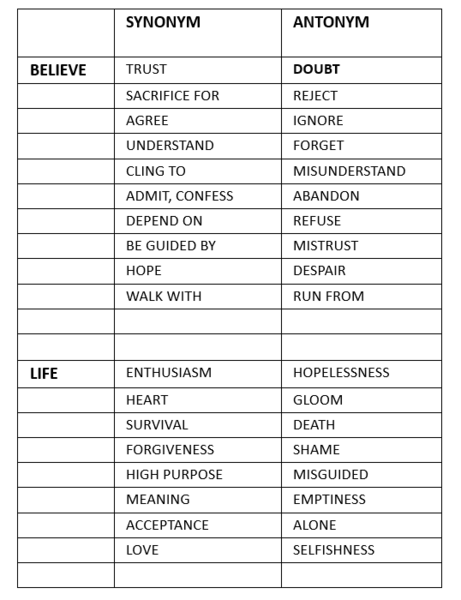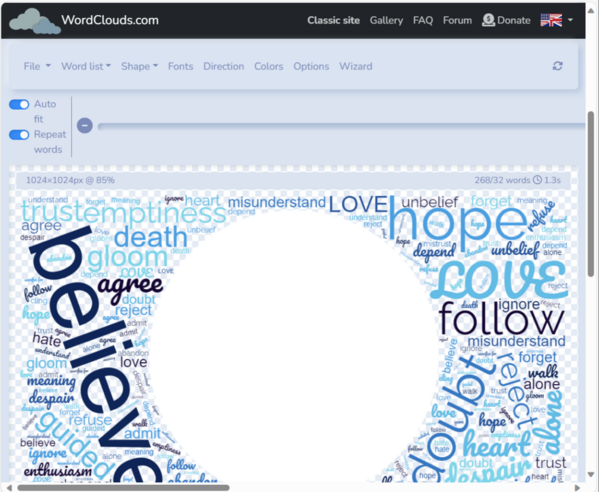What does it mean to "BELIEVE" and "HAVE LIFE" in Jesus?
...and what does it mean to "doubt" ?
A Doubting Thomas Word-Art and Acting Lesson
for older kids and youth
In his John 20 encounter with "doubting" Thomas, Jesus said two important things that are aimed directly at us:
- Stop doubting and believe. (v27)
- Blessed are those who have not seen but believe. (v29)
Then John himself addresses us by ending his Gospel with these words:
"These are written that you may believe that Jesus is the Messiah, the Son of God, and that by believing you may have life in his name."
If you're counting, the word "believe" is used three times here at the end of John's Gospel.
So what does it mean to BELIEVE in Jesus?
And what does it mean to HAVE LIFE in his name?
And what does it mean to "doubt" (and is "doubt" a bad thing?)
The following lesson sketch is designed to help children understand these important words and concepts.
LESSON ACTIVITIES
The words "believe," "doubt," and "life" are important theological and personal words. By working through their possible synonyms and antonyms, we'll better define them, and learn what they mean in our lives. Feel free to elaborate as you work through these activities.
Begin by reading the story of "Doubting Thomas" in John 20.
Notice that Jesus waited a WEEK to appear to Thomas! What does that tell you about why some people "get" Jesus and others are still waiting to understand and feel his presence and understand?
Notice that Jesus "blessed" those who don't get to see and touch his body and hands. Who is he talking about? (us) Why is it more "blessed" to believe without seeing? (One answer is that faith is something we see with our heart, not our eyes.)
Do you think it would help to be able to touch Jesus now? why/why not?
How many people got to see, hear, and touch Jesus during his ministry but didn't believe in him, and in fact, rejected him? What does that say about the nature of belief?
Why do you suppose God didn't just "wave his God-hand" and make everybody believe in Jesus? (One possible answer is that God wants us to make the journey, struggles, doubts, and all to humble us.
What do we learn about God and faith by having to share the message, struggle with it, and encounter others who don't believe it?
Then use one, two, or all three of the following activities:
- Explore Synonyms and Antonyms for the words "Believe" and "Life." See and print the starter-chart below. Recreate the chart on your board or flipchart with a few examples, and then invite students to come up with their own synonyms and antonyms. In the "Acting Out" activity, they'll see these again and act them out.

- Creating a "Word Cloud" picture of yourself using synonyms and antonyms for these important words. This wordcloud can be created by hand as a quick drawing project, or by using the super-easy-to-use "Word Cloud Generator" at wordclouds.com.
 See the wordart example below and invite students to create their own "self portrait" of belief and doubt and life. You can also introduce them to wordclouds.com and have them generate their OWN wordcloud and print it (if you have a computer lab setup). See the wordclouds.com screenshot at the end of this lesson! It's a fun and easy online tool to use.
See the wordart example below and invite students to create their own "self portrait" of belief and doubt and life. You can also introduce them to wordclouds.com and have them generate their OWN wordcloud and print it (if you have a computer lab setup). See the wordclouds.com screenshot at the end of this lesson! It's a fun and easy online tool to use.
Alternatively, you can simply open the attached wordart/wordcloud PDF and print it from your browser. Then have students work on adding their self-portrait and any additional words you/they may wish to add.
- Acting Out various synonyms and antonyms, such as, "walk with" and "run from." Using the list of synonyms and antonyms provided in below and those you and your students come up with, write each on a slip of paper and put them all in a basket. Then pass around the basket so that each student can pull a slip and have some time to think about how they are going to ACT OUT what's on their slip. Remember that each acted-out word is an opportunity for the teacher to elaborate, add more insight, and ask questions!
Some key teaching points:
Point out that there's a reason why the wordart has all the synonyms and antonyms mixed together to form the outline of a person (who will look like you when you're finished). That reason is that ALL of us are a mixture of belief and doubt, love and fear, following and walking away, etc etc.
And here are three Bible verses that remind us of our "dual" or "conflicting" imperfect natures:
1. When Peter sank in the waves, Jesus had to rescue him. And when he got in the boat, what did he say to the disciples? He said, "O Ye of little faith!" It was a lament, not a condemnation. (Matt 8)
2. When the man asked Jesus to heal his sick daughter, and Jesus asked him if he believed, do you remember what the man said? He said, "Lord I believe, HELP MY UNBELIEF!" And Jesus healed his daughter. (Mark 9)
3. When Jesus was dying on the cross, do you remember what he said about us? He said, "Father forgive them, they don't know what they are doing." Not a lot has changed about people since then! We still don't know everything. We still have doubts and we still sin. But now through the gift of belief given to us by the Holy Spirit, we know that God still loves us, and we feel called to live forgiven and forgiving lives. That's what it means to "have life" -- the kind of life Jesus wants for us.
About WordClouds.com
The easy to use online word-art generator.
www.Wordclouds.com is a free and fantastic website. It's so easy to use even adults will be able to use it! And if you have trouble, ask a 12 year old to help you ![]() Because it works in a web browser, it can be used on PCs, Macs, Chromebooks, iPads, and Android tablets.
Because it works in a web browser, it can be used on PCs, Macs, Chromebooks, iPads, and Android tablets.
 There's another very similar online tool at www.wordart.com. It has a smaller number of shapes but they are more artsy than those at wordclouds.
There's another very similar online tool at www.wordart.com. It has a smaller number of shapes but they are more artsy than those at wordclouds.
Below is a screenshot of the wordclouds.com site. Takes about ten minutes to create a single decent word-art. You can then save it as a jpg or pdf or print it. Play with the controls in advance so you can help student know what to do (and not do).






